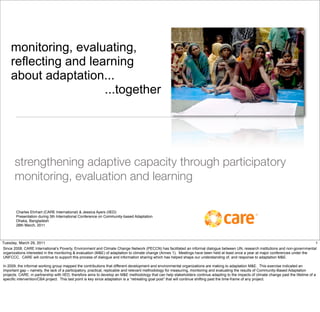
Session 2_Charles Ehrhart_Participatory m&e
- 1. monitoring, evaluating, reflecting and learning about adaptation... ...together strengthening adaptive capacity through participatory monitoring, evaluation and learning Charles Ehrhart (CARE International) & Jessica Ayers (IIED) Presentation during 5th International Conference on Community-based Adaptation Dhaka, Bangladesh 28th March, 2011 Tuesday, March 29, 2011 1 Since 2008, CARE International’s Poverty, Environment and Climate Change Network (PECCN) has facilitated an informal dialogue between UN, research institutions and non-governmental organizations interested in the monitoring & evaluation (M&E) of adaptation to climate change (Annex 1). Meetings have been held at least once a year at major conferences under the UNFCCC. CARE will continue to support this process of dialogue and information sharing which has helped shape our understanding of, and response to adaptation M&E. In 2009, the informal working group mapped the contributions that different development and environmental organizations are making to adaptation M&E. This exercise indicated an important gap – namely, the lack of a participatory, practical, replicable and relevant methodology for measuring, monitoring and evaluating the results of Community-Based Adaptation projects. CARE, in partnership with IIED, therefore aims to develop an M&E methodology that can help stakeholders continue adapting to the impacts of climate change past the lifetime of a specific intervention/CBA project. This last point is key since adaptation is a “retreating goal post” that will continue shifting past the time-frame of any project.
- 2. specific objective provide robust, reliable information to CBA project stakeholders about: Are we doing the right things (are we prioritizing the right activities to achieve our desired outcomes)? Are we doing them the right way (is our approach appropriate to given socio- cultural, ecological, political contexts)? Are we doing them at the right scale (are we achieving multiple changes at multiple levels so as to allow sustainability)? Tuesday, March 29, 2011 2
- 3. overarching goal support the “adaptive management” of CBA interventions/projects support the “adaptive management” of CBA plans/strategies so that local stakeholders can continue adapting to the impacts of climate change beyond the scope of a specific CBA intervention/project support meso & macro level (e.g. LAPA/ NAPA) information needs ...but not meet project activity or output monitoring and evaluation requirements Tuesday, March 29, 2011 3
- 4. scope of “how to” guidelines participatory development of indicators participatory monitoring participatory reflection and applied learning by multiple stakeholders Tuesday, March 29, 2011 4
- 5. design criteria participatory (empowering) practical (affordable, sustainable & can cope with limited pre-exist. data) replicable (user-friendly in a variety of socio-ecological settings) relevant (support learning at all levels) Tuesday, March 29, 2011 5 This exercise indicated an important gap – namely, the lack of a participatory, practical, replicable and relevant methodology for measuring, monitoring and evaluating the results of Community-Based Adaptation projects. o By “participatory,” CARE means a methodology that is designed as part of a larger strategy to empower women and other marginalized groups. Of course, these methodologies usually draw upon participatory techniques. But what makes a methodology participatory, from our point of view, is its non-extractive nature and contribution to continuous learning for action by local stakeholders (including informed engagement with policy-makers). o By “practical,” we mean a methodology that is affordable and sustainable over time (even for community-based organizations); and can contend with limited pre-existing baseline data as well as uncertainty surrounding climate change projections. o By “replicable,” we mean a methodology that is simple enough to be led by field-level project staff from a wide range of institutions in a variety of socio-cultural and ecological settings. By “relevant,” we mean a methodology that meets conventional needs in the project cycle (e.g. the monitoring and evaluation of project impacts), but can also contribute to learning and adaptation planning at sub-national and even national levels.
- 6. design process background review of opportunities & obstacles shared in Feb. 2011 Field-guide (v.1.0) produced by April 2011 Field-guide (v. 2.0): late-2012 the field-guide plugs into an on-line CBA Toolkit built to facilitate the integration of best practices into CBA projects the field-guide will address the role of M&E at different stages in the project cycle Tuesday, March 29, 2011 6 The methodology will be incorporated into CARE’s Community-based Adaptation (CBA) Toolkit and enhance its overall use-value. Version 1.0 of the CBA Toolkit offers a “how-to” guide for practitioners as they go through the project cycle. It includes step-by-step guidance and recommended tools for all stages of the project cycle, along with links to useful resources and checklists for key project documents. It also includes CBA Project Standards to help ensure high-quality analysis, design, implementation and information/knowledge management (including monitoring & evaluation).
- 7. Oxfam IISD Practical Action Indigo Red Cross/Red Crescent (IFRC) Mercy Corps IDS, Sussex IDRC CCAA WRI CARE ACCRA IIED Tuesday, March 29, 2011 7 A number of NGOs, research organisations, and bi-laterals are engaging in the process of developing, testing and/or revising the methodology on the basis of lessons learnt over the next few years.
- 8. More information: www.careclimatechange.org Tuesday, March 29, 2011 8
